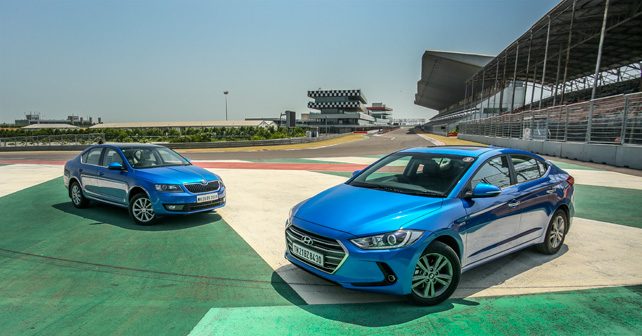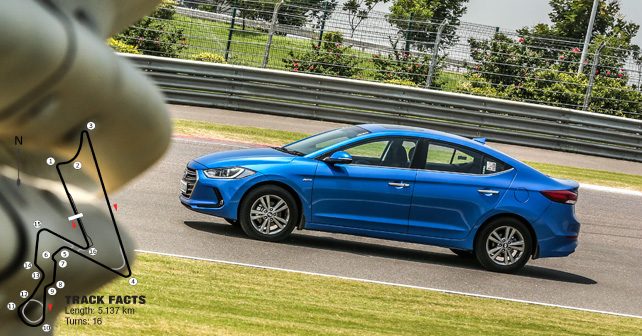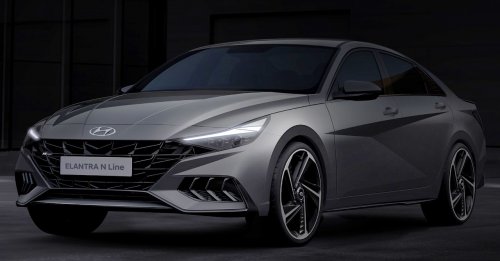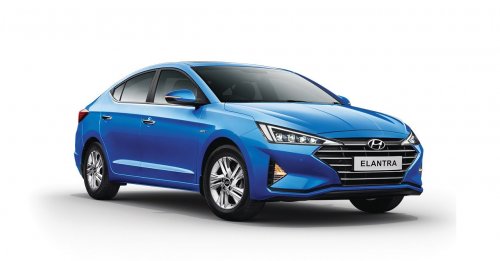The new Elantra certainly looks the part, but what happens when you grab it by the scruff of its neck. Well, that’s what we’re at the BIC to find out. And we brought the Octavia along, in a matching shade of electric blue, to keep it honest.
Now we’re well aware that these aren’t sports sedans. And while you may not be setting record times during the daily commute, at the back of your mind you want to know which one is faster – don’t you? Well, that’s what we’re at the beautiful Buddh International Circuit to find out – because that’s the one place where we can unequivocally determine which one will set your heart racing. No matter the machine, this is our arena to reveal absolute truth in engineering!
They say a blue flame is the hottest kind. So it’s only fitting that these two models are at the top of their respective ranges – kitted out with everything from modern turbo-diesels and automatic transmissions to sunroofs and electric seats (they’re even ventilated in the Elantra). But the determining factor in this test is likely to be the fact that the Octavia has a 2.0-litre motor that produces 141 horses and 320Nm of torque, while the Elantra has a smaller 1.6 that generates 126bhp and 260Nm. The Skoda also has a six-speed dual-clutch that performs rapid-fire gear changes as compared with a considerably more relaxed six-speed torque converter automatic in the Hyundai. But the Skoda’s more advanced drivetrain will cost you just over three lakhs more than its more moderately priced rival – which is the price of a small car!
On the open road, the Elantra ticks all the right boxes. It’s extremely refined. The latest generation Hyundai’s have taken massive strides in the ride-and-handling department, and the Elantra is no different. The suspension is very well damped and soaks up everything the road throws at it. It could use a little more suspension travel, but the flip side is that its road manners at high speed are absolutely impeccable. Once the preserve of European machines, developed on Autobahns and Autostradas, the Hyundai is now just as comfortable as its Czech rival at high three-digit speeds. But the racetrack magnifies any and all shortcomings. The engine and gearbox, on the road, is more than adequate. It won’t throw you back in your seat, but it won’t leave you asking for more either. But let’s get on the track to see which one of this duo lights the hotter flame.
First up was the Octavia to lay down the gauntlet. I owned the first generation of the high performance Octavia vRS, so I know just how good this platform has always been. Now, based on VW’s MQB architecture, the Octavia is better than ever. As we head out on track, the Skoda feels sharp, precise and immediate. The gearbox snatches one gear from the next in quick succession, and the speeds climb quickly on the back straight – the speedo shows 186km/h, but the VBOX reveals a true top speed of 178km/h. At the end of the back straight, the Octavia feels very stable on the brakes, but the heavy front-end washes wide as you turn in for the downhill C4. Note to self – carry less speed through there. A note summarily dismissed every time I attempted to make that corner!
Through the fast double apex left at five and six, you can feel the traction control catching the brakes on occasion even though I’ve turned off the electronic safety net. Through the long parabolica at turn ten, there’s a lot of body roll – which reveals just how softly sprung the Octavia is in order to achieve a compliant ride. On the whole, though, the Octavia proves extremely competent when pushed to the limit – if not overly entertaining. What really separates this from the Elantra, though, is the gearbox – and the fact that it has paddles on the steering wheel makes it even more effortless to execute shifts on demand.
As I head out of the pit lane in the Elantra, the first thing I notice is that the all-black cabin feels by far the sportier of the two – in keeping with its more aggressive styling language I suppose. The driver environment certainly has a more cockpit-like feel to it. In typical BMW-fashion, the centre console is slightly angled towards the driver – where a big screen gives way to a cascading console that houses very intuitive and clear AC controls. Alongside the gear lever there’s a ‘Drive Mode’ button to select between Eco and Sport. I duly engage Sport, turn the traction control off, and attack the first couple of corners. What surprises me is the fact that the steering feels nicely weighted. It has a bit of heft to it, and is quite direct – even if true on-centre feel is well and truly a thing of the past. The brakes, which feel slightly wooden on the road, are extremely sharp and direct as well. Moreover, a compliant ride means that I can attack the kerbs with complete abandon – which is exactly what I’m going to have to do if I stand any chance whatsoever of matching the Octavia.
There’s less body roll in the Elantra, and it seems to have more outright grip as a result. In fact, if you look at the telemetry charts (and focus on the dips in the blue line relative to the red), you’ll notice that the Elantra actually carries more speed through the corners than the Octavia, because it rolls less and has more outright grip. But, ultimately, the lower horsepower and torque figures mean a true top speed at the end of the back straight of 163 – which is 15km/h less than the Skoda. More than that, though, I probably lost a lot more time tussling with the gear lever in my many futile efforts to select a lower gear while entering and exiting a corner. Clearly, despite Sport mode, the gearbox works best when it’s unhurried. Kick-down is pretty good in Drive on the road, but you get the sense that the transmission would rather opt out of the arduous task of attempting to set a lap time at the track. What this results in is a 2.5 second deficit to the Octavia after 5.1 hard fought kilometres of the Buddh International Circuit.
So, on this day, on this track, the Korean has to concede to the Czech. But, the question is if this will have any bearing whatsoever on the sales charts? You see, the Hyundai offers you everything you need on the road – and then some (ventilated seats: check)! But if you want outright performance, Skoda still rules this segment. It will cost you though…

- Skoda Octavia 2.0 TDI
- Hyundai Elantra 1.6 CRDi
Fuel: Diesel
Transmission: 6-Speed DSG Automatic / Front-Wheel Drive
Power:141bhp @ 4,000rpm
Torque: 320Nm @ 1,750-3,000rpm
Price: Rs22.65 lakhs Lakhs (Ex-showroom, Delhi)
X-FACTOR: An engine and transmission combination that can’t be beat – but one that’ll burn a hole in your pocket!
Fuel: Diesel
Transmission: 6-Speed Automatic / Front-Wheel Drive
Power:126bhp @ 4,000rpm
Torque: 260Nm @ 1,900-2,750rpm
Price: Rs.19.19 Lakhs (Ex-showroom, Delhi)
X-FACTOR: Everything you need, and more, to keep you happy for endless miles of motoring – but it’s not too keen to go pounding around the track for no particular reason.
| CURRENT TESTS | Lap Time | Top Speed |
| Skoda Octavia 2.0 TDI | 2:45.2 | 178 (Km/H) |
| Hyundai Elantra 1.6 CRDi | 2:47.6 | 163 (Km/H) |
* Slightly different circuit layout, W = Wet
Also read: BMW 7 Series vs Z4 : Track Test






































Write your Comment